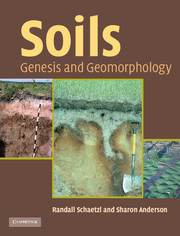Book contents
- Frontmatter
- Contents
- Preface
- Acknowledgements
- Part I The building blocks of the soil
- Part II Soil genesis: from parent material to soil
- Part III Soil geomorphology
- 13 Soil geomorphology and hydrology
- 14 Soil development and surface exposure dating
- 15 Soils, paleosols and paleoenvironmental reconstruction
- 16 Conclusions and Perspectives
- References
- Glossary
- Index
13 - Soil geomorphology and hydrology
from Part III - Soil geomorphology
- Frontmatter
- Contents
- Preface
- Acknowledgements
- Part I The building blocks of the soil
- Part II Soil genesis: from parent material to soil
- Part III Soil geomorphology
- 13 Soil geomorphology and hydrology
- 14 Soil development and surface exposure dating
- 15 Soils, paleosols and paleoenvironmental reconstruction
- 16 Conclusions and Perspectives
- References
- Glossary
- Index
Summary
Geomorphology is the study of landforms and the evolution of the Earth's surface. Because soils are so strongly linked to the landforms upon which they develop, a discipline has emerged that deals with those relationships: soil geomorphology. Birkeland (1999) defined soil geomorphology as the study of soils and their use in evaluating landform evolution, age and stability, surface processes and past climates. Wysocki et al. (2000) more broadly defined it as the scientific study of the origin, distribution and evolution of soils, landscapes and surficial deposits and the processes that create and alter them. Perhaps the definition we like best is that soil geomorphology is an assessment of the genetic relationships between soils and landforms (Gerrard 1992).
Soil geomorphology was first studied as a project area by the US National Cooperative Soil Survey (NCSS) program in the 1930s, as interests had developed among geographers, geologists and soil scientists on the relationships between soils and landforms (Effland and Effland 1992). Seeing the merit in this type of approach, the NCSS adopted soil geomorphology as a paradigm for studying and classifying soils. Early soil geomorphology studies were grounded in the work of Carl Sauer, a geographer at the University of California (Effland and Effland 1992). Many focussed on soil erosion. Later, under the leadership of Charles Kellogg, assisted by Guy Smith, the NCSS program embarked upon a research mission to understand soil–landform relationships in the major climatic areas of the United States, in support of its soil mapping program.
- Type
- Chapter
- Information
- SoilsGenesis and Geomorphology, pp. 465 - 546Publisher: Cambridge University PressPrint publication year: 2005
- 1
- Cited by



